Continuous employee training is crucial for staying competitive, but it doesn’t come without a cost — employers worldwide spend thousands on employee learning and development. However, it’s not that simple and always effective.
With so much focus and investment going into training programs, how can employers help ensure that their efforts to improve job performance are a good use of their resources? In this article, we will explain how needs analysis helps companies make smarter decisions around this, plus a monday.com needs analysis template for any size team.
What is needs analysis?
Needs analysis is a formal, structured, systemic process of identifying and evaluation training that should be done, or specific needs of an individual or group of employees. The term “needs”, also referred to as “gaps,” refers to an individual or group’s training and upskilling requirements to reach their peak performance.
At your place of work, you might call a needs analysis a “needs assessment” or “gap analysis.” Either way, this evaluation process serves the purpose of identifying flaws and finding training solutions to help meet organizational goals. It ultimately serves to bridge performance gaps and issue more effective training in the long run.
Why use needs analysis?
Needs analysis serves to highlight problem areas and take actionable steps toward improvement. However, the benefits of performing a needs analysis extend beyond just insight. Your company can use a needs analysis as a tool for instructional design that enhances job performance from root to tip. It can also help you identify training methods that bring the best out of your employees.
A company that doesn’t regularly perform a needs analysis may miss opportunities to improve methodology, training, and strategies for hitting targets.Here are a few more major reasons to implement needs analysis for your teams.
Helps identify opportunities for growth and learning
Identification of a problem is the first step toward growth. If an employee is silently struggling with a certain skill set, a needs analysis will kickstart the necessary awareness to make a change.
Positions teams to reach individual and company-wide goals
Sometimes, all it takes to reach big goals is a reshuffling of tools, skills, and responsibilities. A needs analysis can give teams and individuals a fresher, more productive structure to work with. Ensuring specialized individual training will help teams function better, contributing to company success. For example, if a team leader takes a public speaking course, their ability to present information to their team improves, allowing for more effective communication and delegation of tasks.
Prioritizes the most important and impactful training
Being aware of company weaknesses or improvement areas is essential for moving forward. A needs analysis can help companies bolster weak spots and make the most out of peak performance areas.
There are multiple benefits to running a needs analysis for any team with big dreams. Once the analysis has been executed, it becomes easier to organize information and prioritize the needs of the business. In this way, managers and supervisors can issue a training program that truly meets the needs of employees, without wasting time or budget on lower-priority activities
When might you use needs analysis?
Performing regular assessments within your company is crucial for staying afloat. This is especially true now, as teams from around the world struggle to adapt to the many changes that have been flung our way by the pandemic.
To deepen your understanding of the importance of needs analysis, let’s cycle through three examples of when needs analysis is required.
1. Adapting to a digital workplace
Even though digital workspaces have become significantly more popular over the past two years, many people are still struggling to adapt. A report Beezy found that 61% of employees are not satisfied with their company’s tools and technologies.
A training or learning needs analysis like the one below can be used to provide employees with the education and support they need to reduce digital performance problems.
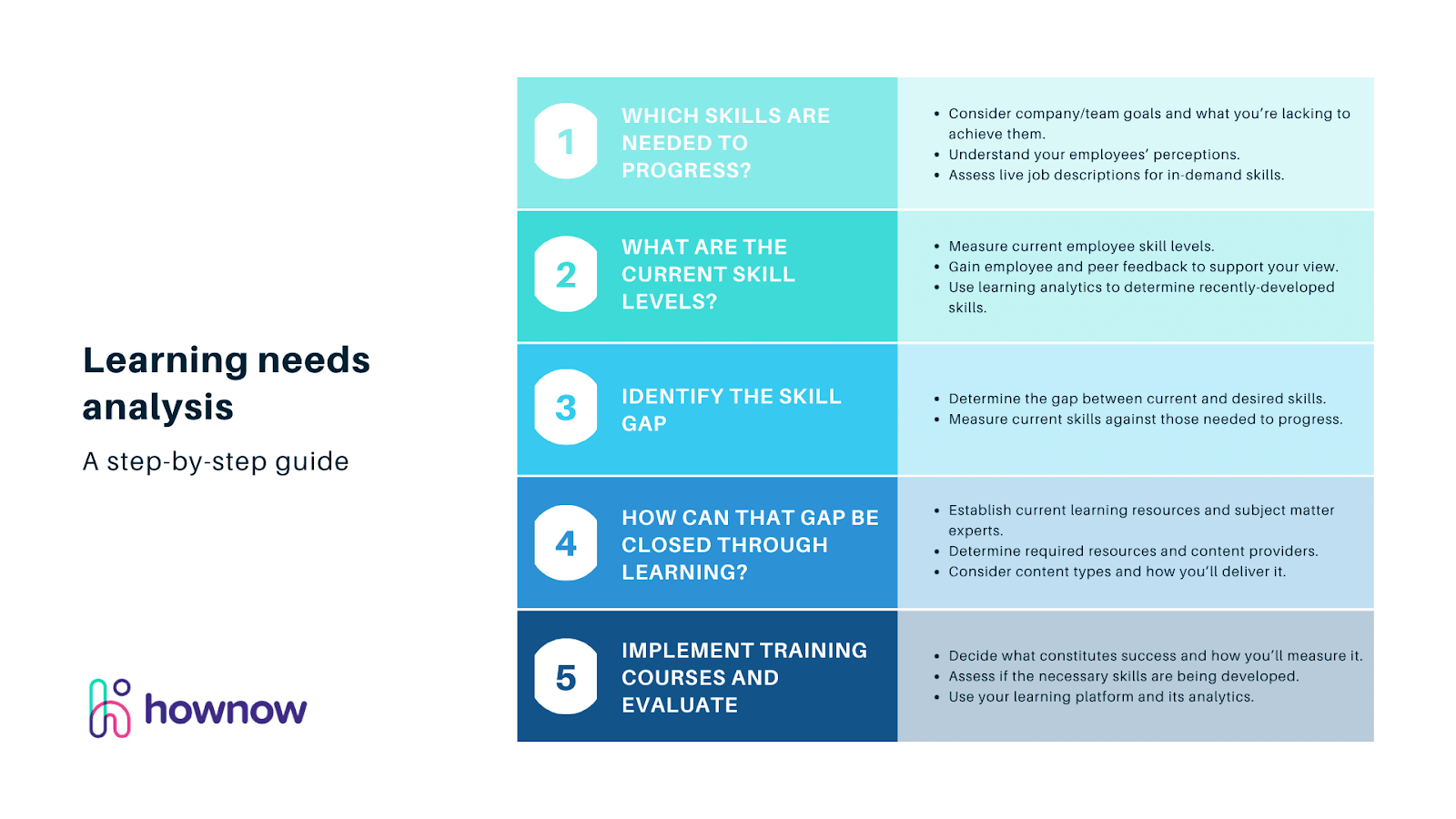
2. Implementing effective time management
Time management is a common area for improvement within teams, especially as communication and time tracking methods have had to change dramatically in the past two years. Digital communication within teams has skyrocketed, and time tracking has become a common requirement of remote jobs.
A needs analysis report will shed light on how much your employees are struggling to manage time. The following needs analysis questions will provide you with a clear picture of where to invest in training.
3. Maintaining employee and team morale
According to Gallup’s State of the Global Workplace Report, a staggering 67% of employees are “not engaged” in the workplace, and it shows. Global stress, anxiety, and depression levels have inevitably leaked into the business sector, making it hard for employees to emit high job performance.
You can use a needs analysis to create an effective training program to tackle these issues within the workplace and help employees regain a sense of pride and joy in their work or to understand what resources you might want to provide, like mental health support or team bonding activities.
How to conduct a needs analysis
Understanding exactly what your team needs to meet organizational goals and improve performance is key. This is where a needs analysis comes in. Think of it as your roadmap to uncovering gaps in performance and pinpointing the best training solutions. Let’s dive into the steps needed to conduct a thorough needs analysis.
Step 1: Define the goal of your assessment
Every journey starts with a destination in mind, and a needs analysis is no different. Begin by defining the goal of your assessment. What are you trying to achieve? Are you aiming to boost sales team performance, enhance customer experience, or address specific organizational issues (like a lack of knowledge in a certain area or new market)?
By clarifying these objectives, you get a bird’s-eye view of what needs to change. This initial step is crucial for aligning your analysis with your organization’s strategic goals and making sure you’re targeting the right performance issues. Knowing what you’re aiming for will guide the entire assessment process.
Step 2: Decide on budget and capacity
Knowing your budget and capacity upfront can save you a lot of headaches down the line. You don’t want to plan a training program without knowing how much you can spend on it right?
Allocating the right budget ensures that you have the capacity to explore all levels of training needs. This way, you can involve project partners if necessary and make sure you have the manpower and tools needed to conduct a thorough analysis.

Step 3: Identify target audiences and data sources
Identifying your target audiences and data sources is a critical step. Are you focusing on the sales team, customer service, or perhaps the entire organization?
You’ll need to pull data from various sources such as performance evaluation surveys, customer surveys, your CMS, and other data sources.
Step 4: Conduct the analysis
With your data sources and target audiences identified, it’s time to roll up your sleeves and conduct the analysis. This is where you gather and evaluate data to identify skill gaps and performance issues.
Utilize popular methods like interviews, surveys, and competitive analysis to get the insights you need. Look at both the current level of performance and areas that need improvement. This process will help you understand why people are performing the way they are and what training could potentially fix.
Step 5: Summarize the results
Once your analysis is done, summarizing the results is key. This summary should be clear and organized, providing an overview of the performance issues and gaps you’ve identified.
Use visuals like charts and graphs to make the data easier to digest. Highlight the main findings, such as specific skill gaps that need addressing or any common issues affecting performance. A well-documented summary will be invaluable for communicating your findings to stakeholders.
Step 6: Get feedback from key stakeholders
Before you finalize anything, getting feedback from key stakeholders is essential. This ensures that your analysis aligns with their expectations and the organizational goals.
Engage with project stakeholders, team leaders, and even potential customers to validate your findings. This collaborative approach helps fine-tune your analysis and ensures everyone is on the same page, making it easier to implement the necessary changes.
Step 7: Share the analysis
After you incorporate everyone’s feedback, it’s time to share your analysis. Clear communication is crucial to make sure everyone understands the findings and the action plan.
Create a detailed report or presentation to share with all relevant parties, from the sales team to upper management. This step is about transparency and making sure everyone is aware of what needs to be done to address the issues you’ve identified.
Step 8: Take action
Finally, armed with insights from your needs analysis, develop and implement training initiatives that target the identified gaps.
Use your findings to design training programs that align with your organizational goals. Monitor the impact of training on employee performance and customer satisfaction to ensure your efforts are paying off. This step turns your analysis into a tangible action plan that drives improvement.
Following these steps will ensure that your training solutions are not just effective, but also aligned with your strategic goals, leading to improved performance and a better customer experience.
monday.com’s needs analysis template
The process of identifying a strong needs analysis design doesn’t need to be complicated. monday.com has developed a needs analysis template that can be used to help companies from all over the world identify training gaps. Other benefits include:
Transforming your needs analysis into actionable tasks
Once you have concrete data on the state of your employees’ performance, assigning actionable steps to those in charge becomes much easier. Quickly assign tasks to your teammates, whether that’s to watch a training video or sign up for a microlearning course. Use statuses and automations to make it a breeze to understand where things stand at a glance — and from one central location.
Creating a training program based on your needs analysis
Your team deserves a training needs analysis that meets their strengths and weaknesses. monday.com’s template can be seamlessly applied to any employee, team, or industry for more succinct results.
For example, the template includes an overview of company goals ranked by priority. This allows your team to easily visualize what needs to be done to meet those goals and makes it easier to delegate training and tasks based on the skills of your team members.
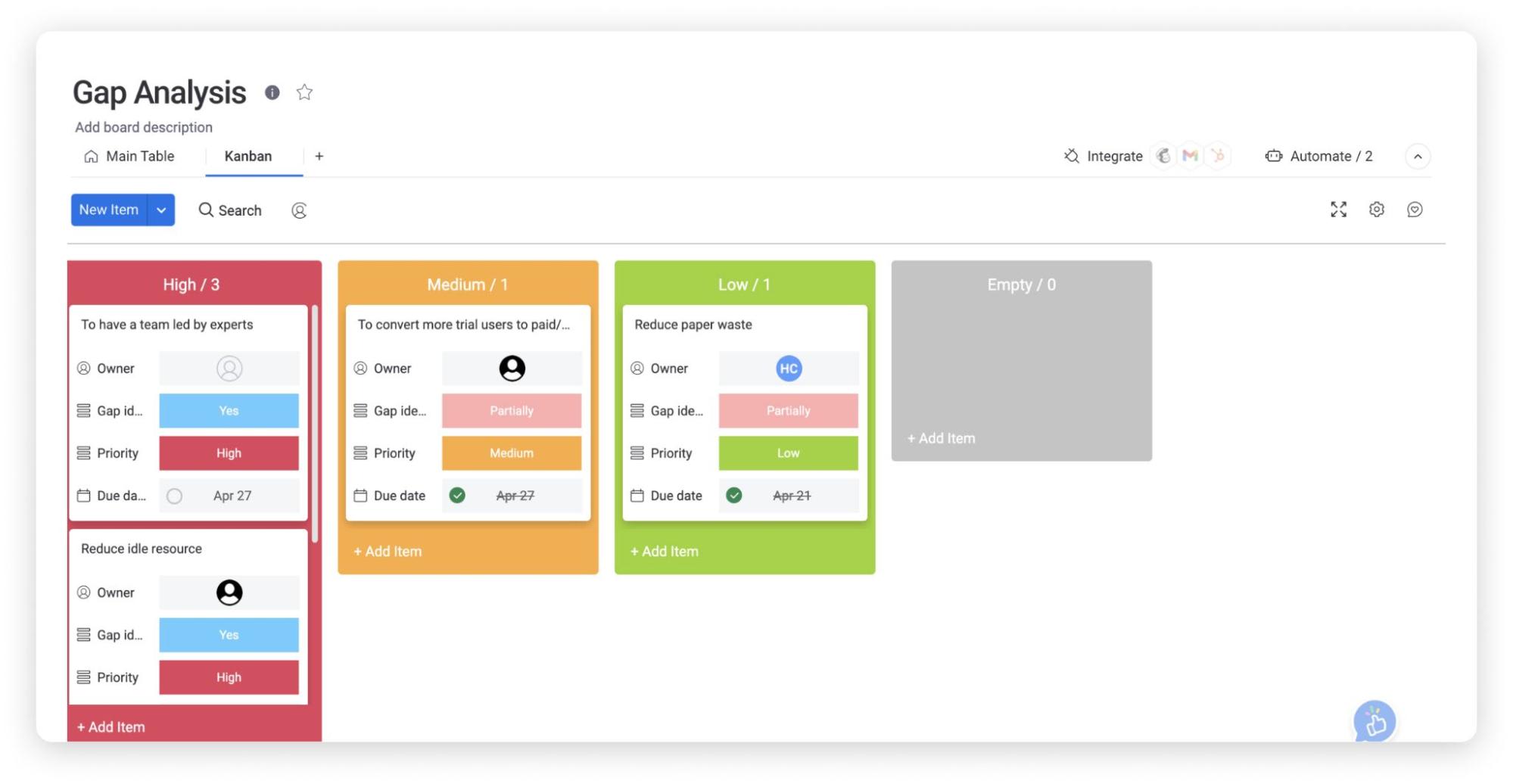
Tracking your team’s progress
Progress tracking is one of the most valuable tools a company can use to maintain momentum. And monday.com’s needs analysis template reflects employee data in a clear, concise way. With our Performance Insights View, you can easily analyze your team’s overall performance to see how your training program is impacting overall productivity.
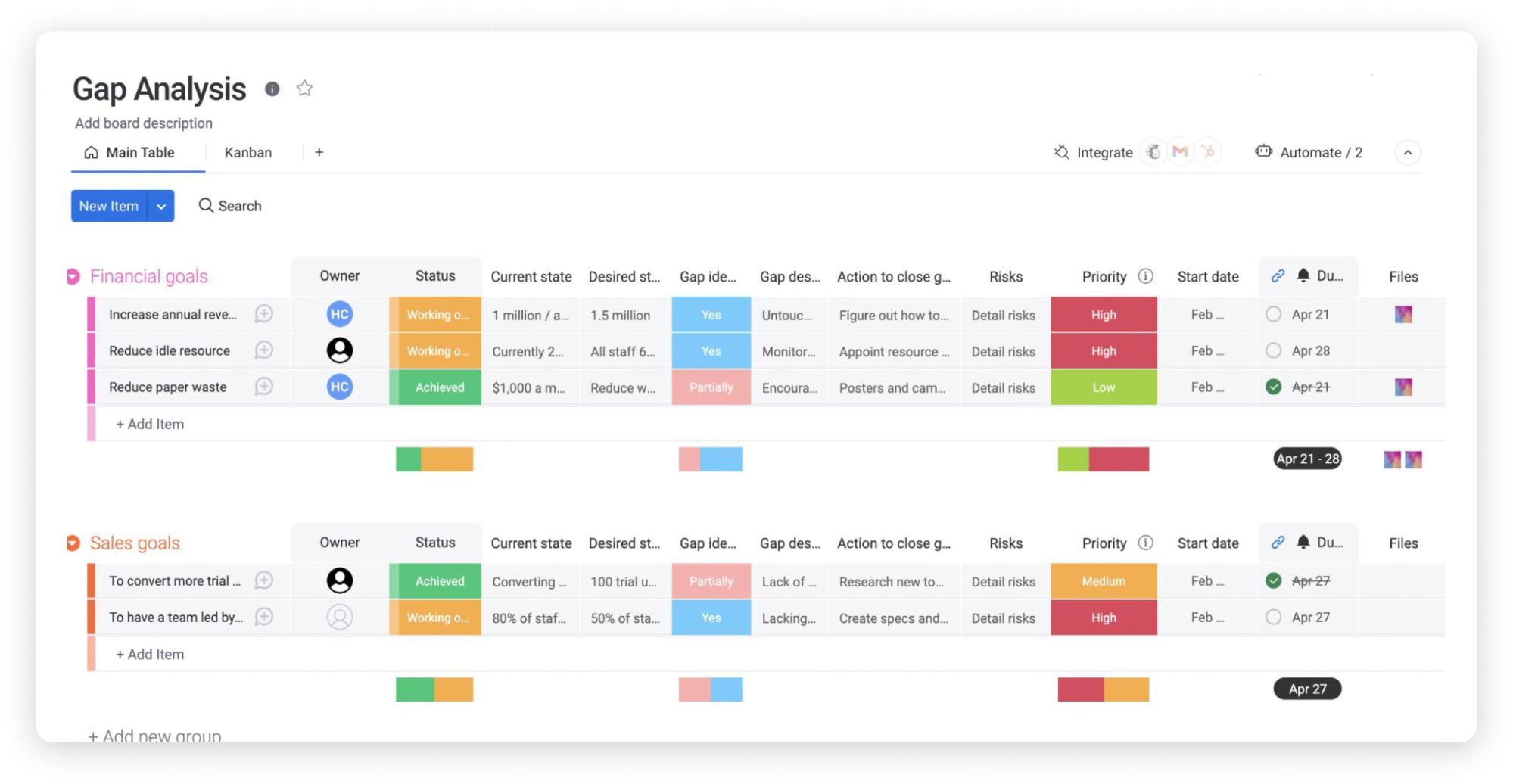
Engaging with employees
Employee engagement is one of the most important tools in the proverbial business box right now. You can use monday.com’s template as the starting point for an engagement and morale turnaround that pushes everyone into the next tier of productivity. Send a message to any team member with an @mention, and make sure they get the message with instant notifications.
Related templates
Each of these templates can provide companies with a unique approach to training their teams in the most efficient way possible.
1. Employee engagement survey template
Our Employee Engagement Survey Template enables you to send surveys and record responses from one centralized location. It can be used to quickly assess engagement levels, thus allowing for more effective responses to employees’ emotional and mental needs. Their feedback will be added directly to the workspace so that it’s easily visible and can be implemented immediately.

2. HR services template
The Human Resources (HR) Services Template that monday.com offers provides team leaders or managers with insights into employee onboarding, new requests, recently opened positions, and more.
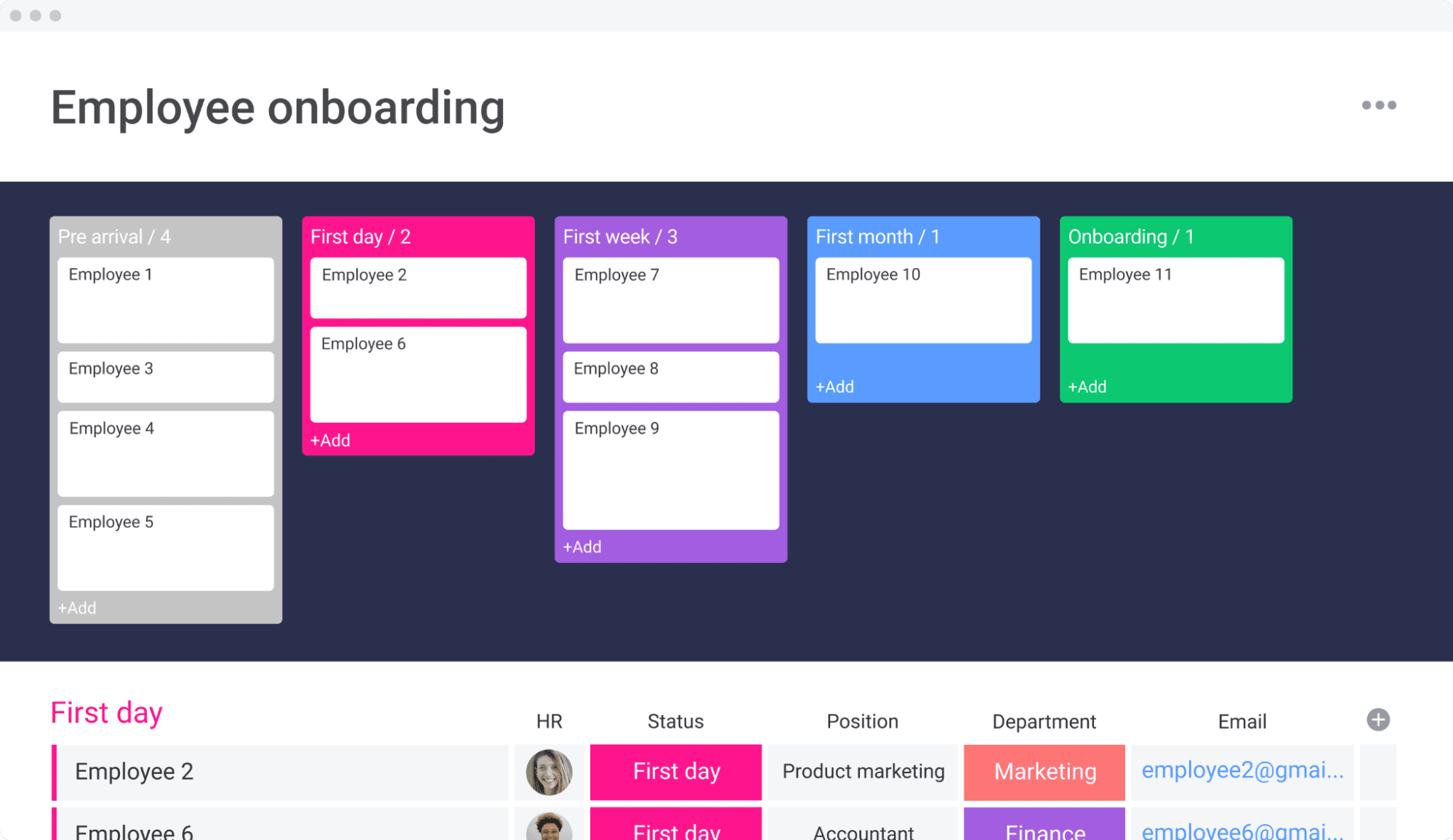
This template is also beneficial in the sense that it is centralized and therefore accessible in one place, permitting easy tracking of employee dates, streamlining HR requests, and keeping up to date with any onboarding processes currently in effect. An important part of new hire onboarding could even include a mini needs analysis to ensure a thorough start.
3. Training program template
A Training Plan Template is designed to guide team leaders in planning and developing a strong training program for employees. Each team is different, which is why a flexible template like this one is perfect for applying to groups of all shapes and sizes. Here is an example of another training plan.

4. Performance improvement plan template
Employees struggling to meet a certain standard of performance might need the push and structure that a Performance Improvement Plan Template can facilitate. This template works by helping employees set small daily performance goals that compound over time to reach long-term goals. Below you can see a basic layout.
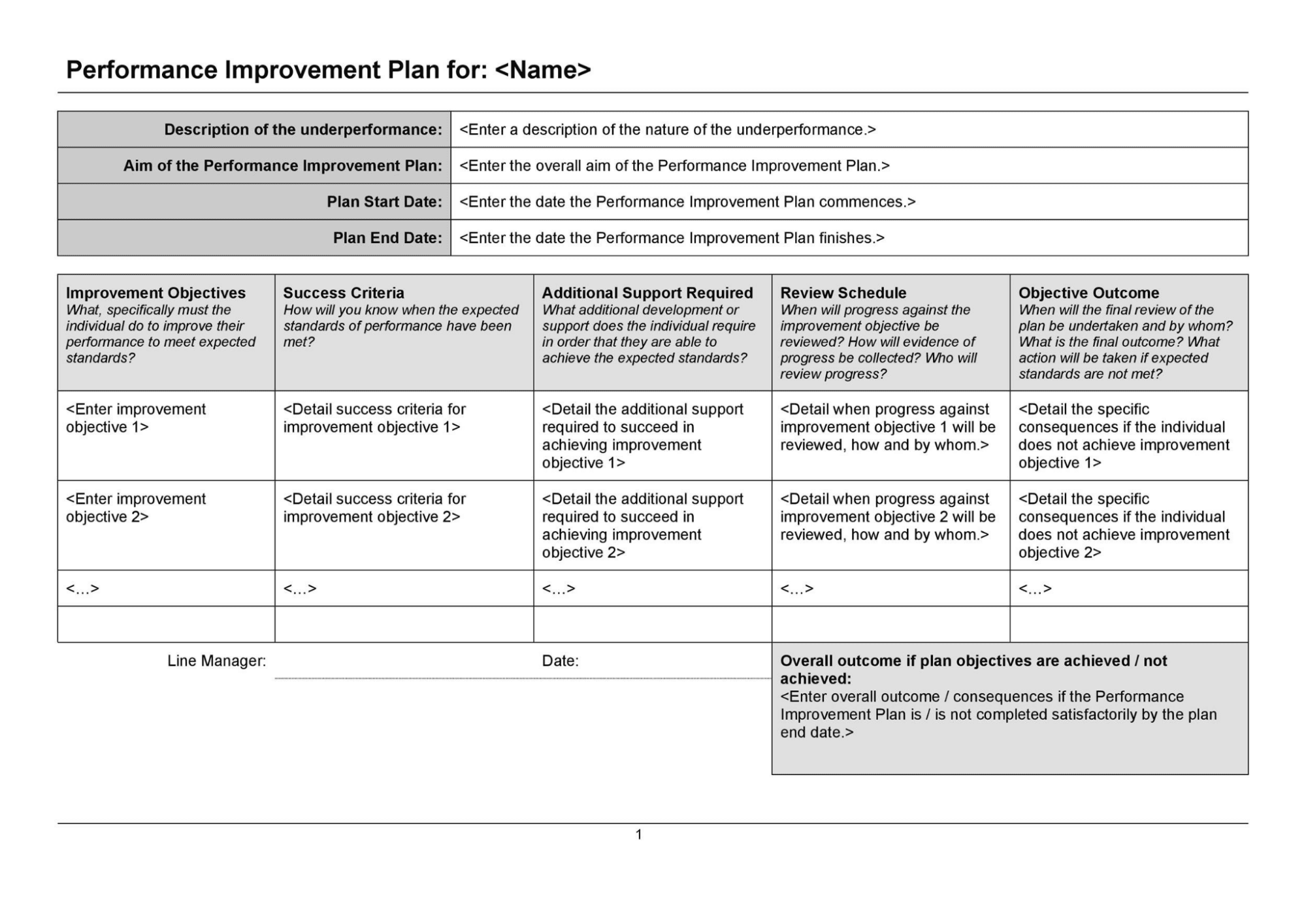
FAQs about needs analysis
What does a needs analysis example include?
A needs analysis typically includes several different stages of assessment:
- Needs identification
- Data collection and analysis
- Data application
- Evaluation
This structure can be applied to teams of just about any size and can be adapted to help configure the right steps and protocols for achieving company-specific goals.
What are the 4 steps in the needs analysis process?
The four steps in the needs analysis process are:
- Understanding long and short-term business goals
- Identifying the desired performance outcomes
- Examining the current performance efforts
- Establishing an appropriate solution
These four steps are essentially there to help support and guide business teams who are unsure of how to reach their projected goals.
How do you conduct a needs analysis?
The easiest way to conduct a needs analysis is by following the steps and guidelines provided by a template. monday.com offers a plethora of professional business templates, including a detailed template to help you conduct a thorough needs analysis. monday.com also makes it easy to communicate the process to employees from a shared workspace.
What are the types of needs analysis?
There are many different types of needs analysis prerogatives. Some of the most common ones include:
- Person analysis: Dealing with experience, learning style, and temperament of employees
- Performance analysis: Focusing on productivity levels and potential performance gaps
- Organizational analysis: Pertaining to whether or not an organization is utilizing the right strategies, goals, and objectives
- Training suitability analysis: Assessment of which training offers the desired solutions
